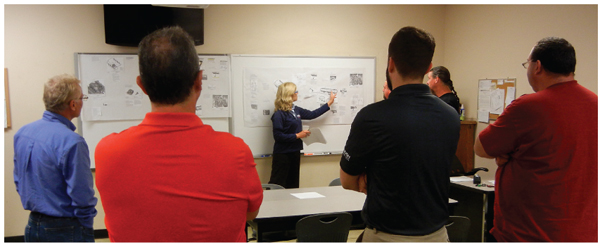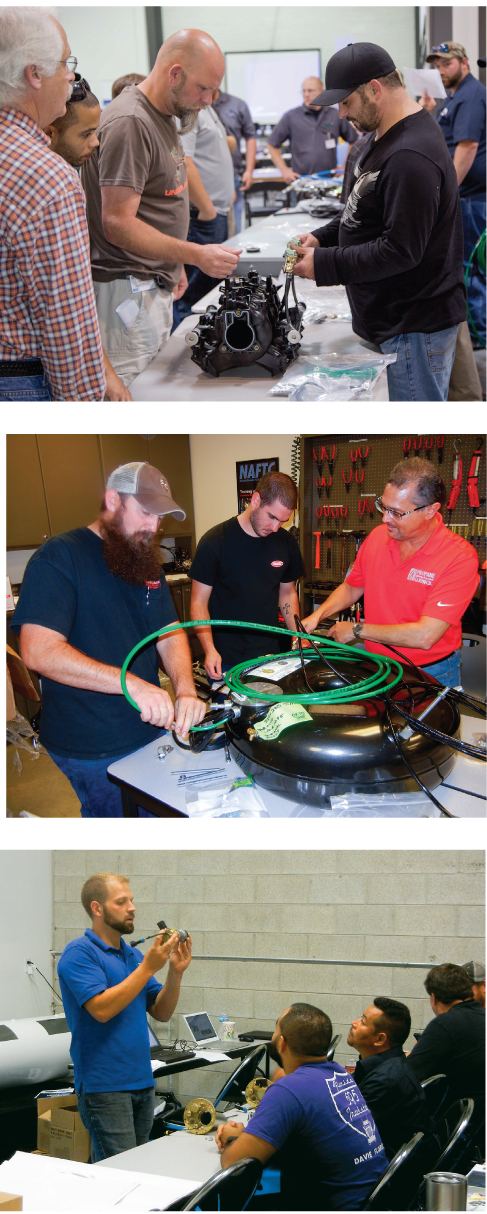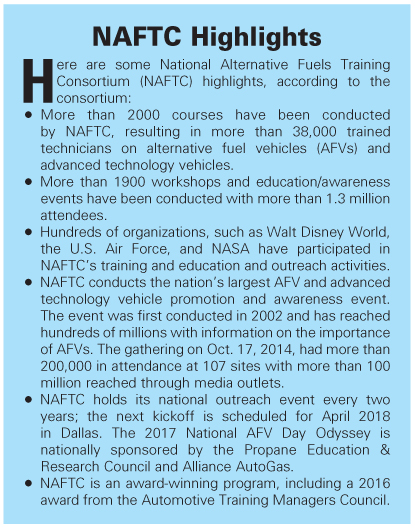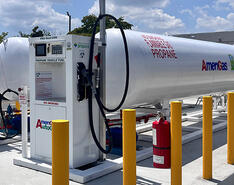Wednesday, July 19, 2017
There’s a movement afoot when it comes to propane autogas training — research and promotion. Federal, state, and local agencies, the Propane Education & Research Council (PERC), and academia are combining efforts to take the clean-burning fuel to new heights. 
“Propane vehicle sales are expected to increase from 12,900 in 2014 to about 34,750 per year by 2020, and then to about 52,500 vehicles per year by 2025,” according to ICF International’s 2016 Propane Market Outlook. “While the introduction of new vehicles and engines has been slower than anticipated, and greater market penetration will be delayed somewhat by the decline in the propane fuel cost advantage caused by lower oil prices, the availability of new emissions-certified engines and the growing acceptance of propane vehicles by commercial vehicle fleet operators, crop irrigators, and commercial landscapers will lead to continuing growth in these markets.”
Already, according to World LP Gas Association, as of 2015, there were more than 26 million autogas vehicles in use around the world. Here are some of the agencies involved in this effort and what they are doing for propane autogas.
NAFTC and PERC
In the last year alone, the National Alternative Fuels Training Consortium (NAFTC), in partnership with PERC, completed the consortium’s Propane Autogas Technician Training Course, and classes have been under way since early 2016.
“NAFTC has offered propane autogas training for a number of years, from awareness training, to fleet training, to automotive technician training,” says Micheal Smyth, NAFTC’s assistant director of training and curriculum development. “In 2014, NAFTC partnered with PERC to update our Propane Autogas Technician Course to reflect the newer technologies that were being used in autogas vehicles. The result of that training, NAFTC’s Propane Autogas Technician Training Course, is being taught around the nation to interested automotive technicians, beginning with the course’s completion in January of 2016. These training endeavors are being underwritten by PERC.” Classes continue to be offered.
PERC has invested about $385,000 in the program since 2015, according to Stuart Flatow, PERC’s vice president of safety and training. “That includes developing the curriculum, various modes of outreach, and 12 training courses,” he says.
NAFTC is a West Virginia University program based in Morgantown, W.Va., where the national training center is also headquartered. With more than 50 member organizations around the world, NAFTC partners with businesses, community and technical colleges, high schools, and other academic institutions to bring training to technicians. “These consortium members offer the training that NAFTC develops in relation to all the alternative fuels, including propane autogas,” says Smyth.
“NAFTC has hundreds of instructors worldwide, and offer our training in a number of different formats. We do training in Morgantown at our national headquarters, offer training with our consortium members, and also do on-site training for interested alternative fuel businesses. PERC and NAFTC are currently developing a five-year plan for continuing the efforts on bringing educational information to all on the advantages of propane autogas for consumers and fleets, and also to train the much-needed automotive technicians on the proper and safe procedures for diagnosing, repairing, and converting propane autogas vehicles,” says Smyth.
Clean Cities
A partner in advancing autogas is Clean Cities. The U.S. Department of Energy’s (DOE) Clean Cities program promotes the nation’s economic, environmental, and energy security by supporting local actions to cut petroleum use in transportation. As part of DOE’s Vehicle Technologies Office, Clean Cities has saved more than 8.5 billion gallons of petroleum since its inception in 1993.
From $10 million in projects affecting multiple states to upgrading pickup trucks for a small North Carolina historical site, Clean Cities’ reach is impressive. At the national level, it develops and supports partnerships, publications, tools, and other unique resources, DOE reports. At the local level, coalitions, numbering nearly 100, leverage these resources to create networks of local stakeholders and provide technical assistance to fleets implementing alternative and renewable fuels, idle-reduction measures, fuel economy improvements, and emerging transportation technologies.
Clean Cities has awarded nearly $400 million to fund more than 600 projects across the country that reduce petroleum use in transportation, according to the organization. These project awards contribute to Clean Cities’ primary goal of reducing petroleum use in the U.S. by 2.5 billion gallons per year by 2020.
Efforts include awards to the Gas Technology Institute, such as one for a more than $10-million project (including $5.2 million in local matching funds) that was launched in December 2016 and impacts Illinois, Michigan, and North Dakota. With this initiative, multi-fuel stations will be deployed with electric vehicle supply equipment, compressed natural gas, biofuel, and propane autogas fueling dispensers, as well as infrastructure to support other alternative fuel vehicles (AFVs) along I-94 from Port Huron, Mich. to the North Dakota border.
The projects are far-reaching and are both large and small. For example, one endeavor, in North Carolina, combines efforts between the Carl Sandburg Home National Historic Site with the Land of Sky Clean Vehicles Coalition to convert two existing pickup trucks to use propane and install an on-site propane fueling station. Additionally, the park plans to replace an older gasoline mower with a new propane mower.
Clean Cities dates back to the 1988 Alternative Motor Fuels Act and the Clean Air Act Amendments of 1990, according to the Clean Cities website. Those laws encouraged the production and use of alternative fuel vehicles and the reduction of vehicle emissions, leading to the creation of the Alternative Fuels Data Center in 1991. The center’s mission was to collect, analyze, and distribute data used to evaluate alternative fuels and vehicles.
The enactment of the Energy Policy Act of 1992 required certain vehicle fleets to acquire AFVs, according to the site. Subsequently, DOE created Clean Cities in 1993 to provide informational, technical, and financial resources to regulated fleets and voluntary adopters of alternative fuels and vehicles.
“NAFTC also has a very close relationship with the Clean Cities organization, and we’re proud to claim Clean Cities as an alternative fuel partner,” says Smyth.
NREL
The National Renewable Energy Laboratory (NREL) assists the Clean Cities program in supporting local actions to reduce petroleum use in transportation by providing technical assistance, educational and outreach publications, and coordinator support, according to the NREL website.
NREL works with vehicle fleets, fuel providers, policymakers and other transportation stakeholders to deploy alternative and renewable fuels, advanced vehicles, fuel economy improvements, and fleet-level efficiencies that reduce U.S. reliance on petroleum-based transportation fuels.
NREL’s technical experts provide the most current in-depth information about alternative fuels, as well as the vehicles that use these fuels and the infrastructure used to deliver them, says NREL. Its experts work to identify and overcome market barriers to the adoption of renewable energy and energy efficiency in transportation, including facilitating collaboration, providing technical expertise and unbiased information on AFVs and fueling infrastructure, developing online tools to help stakeholders evaluate and select the appropriate fuels and technologies, and publishing comprehensive and accurate data.
NREL also collaborates with industry partners to engage with the propane autogas market to identify and address implementation barriers. For example, the Propane Autogas Technology Forum is led by NREL in partnership with PERC and the Clean Cities program. The 2017 meeting, held June 13-14 in Arlington, Va., provided a continued forum for candid discussion about barriers and opportunities related to the deployment of propane vehicles and autogas, according to Clean Cities. By soliciting input in a technically rigorous manner, a broad set of stakeholders will seek to address and identify the most significant technological and market barriers affecting expansion.
Future Budgetary Concerns
While there may be concern about cutbacks in federal funding due to the new administration’s budgetary proposals, officials say it’s too early to tell. For some, their funding comes from other sources.
For PERC, its operations and activities are funded by an assessment levied on each gallon of propane gas at the point it is odorized or imported into the United States, according to its site. When asked if budget cuts are a concern for PERC, Flatow said, “If grants for clean energy are cut, it could be an issue. But yes, basically, funding cuts should not impact PERC assessment.”
While NAFTC’s charter prevents it from sharing specific financial data, Smyth says, “NAFTC looks for funding opportunities from all possible sources. We have been very fortunate in receiving significant support in the past from government agencies such as the Department of Energy, Department of Labor, FEMA [Federal Emergency Management Agency], and others. We have also applied for and received funding from state government sources, private entities, and from both nonprofit and for-profit businesses and organizations for the development and presentation of alternative fuel classes.
“In addition, we supplement our bottom line through performing much needed alternative fuel and alternative fuel vehicle training to interested parties, including businesses, municipalities, and through our great partnership with the Clean Cities Program,” says Smyth.
For Clean Cities and NREL, it’s too soon to tell. “It remains too early to speculate on what possible [budgeting] impacts will be for NREL,” says Heather Lammers, a laboratory spokeswoman. “Although cuts are mentioned for DOE’s Office of Energy Efficiency and Renewable Energy [EERE] — which sponsors roughly 80% of NREL’s funding — there are no specifics in the president’s budget blueprint when it comes to an FY '18 budget for EERE.” The fiscal 2016 budget stood at $427 million, according to NREL’s website.
“Funding comes to NREL via line items in the Congressional Budget, and that funding first goes to DOE. DOE determines how much funding is passed on to the various national laboratories. The other 20% of the lab’s funding comes from a variety of sources, including work for other federal agencies and partnerships with industry. Funding levels for FY '17 have continued under a continuing resolution and we remain focused on our mission to find answers to today’s energy challenges,” Lammers said.
One Program’s Future
Industry experts also remain hopeful for the field. “We see autogas growing at a rapid pace, especially in the school bus market,” says PERC’s Flatow. “To maintain that growth, that market needs qualified technicians trained to troubleshoot, diagnose, and maintain autogas vehicles.
“Without an ample number of such technicians, the autogas market may suffer as end-users may become frustrated about the potential lack of skilled professionals who are able to work on their vehicles without having to travel miles and miles to find one.
“The biggest priority for us is to get NAFTC-member technical schools to adopt the autogas course into their formal automotive curriculum. This will hopefully attract students to take those courses and thus set the stage for a generation of new autogas technicians.”
—Laura Mohammad

“Propane vehicle sales are expected to increase from 12,900 in 2014 to about 34,750 per year by 2020, and then to about 52,500 vehicles per year by 2025,” according to ICF International’s 2016 Propane Market Outlook. “While the introduction of new vehicles and engines has been slower than anticipated, and greater market penetration will be delayed somewhat by the decline in the propane fuel cost advantage caused by lower oil prices, the availability of new emissions-certified engines and the growing acceptance of propane vehicles by commercial vehicle fleet operators, crop irrigators, and commercial landscapers will lead to continuing growth in these markets.”
Already, according to World LP Gas Association, as of 2015, there were more than 26 million autogas vehicles in use around the world. Here are some of the agencies involved in this effort and what they are doing for propane autogas.

NAFTC and PERC
In the last year alone, the National Alternative Fuels Training Consortium (NAFTC), in partnership with PERC, completed the consortium’s Propane Autogas Technician Training Course, and classes have been under way since early 2016.
“NAFTC has offered propane autogas training for a number of years, from awareness training, to fleet training, to automotive technician training,” says Micheal Smyth, NAFTC’s assistant director of training and curriculum development. “In 2014, NAFTC partnered with PERC to update our Propane Autogas Technician Course to reflect the newer technologies that were being used in autogas vehicles. The result of that training, NAFTC’s Propane Autogas Technician Training Course, is being taught around the nation to interested automotive technicians, beginning with the course’s completion in January of 2016. These training endeavors are being underwritten by PERC.” Classes continue to be offered.
PERC has invested about $385,000 in the program since 2015, according to Stuart Flatow, PERC’s vice president of safety and training. “That includes developing the curriculum, various modes of outreach, and 12 training courses,” he says.
NAFTC is a West Virginia University program based in Morgantown, W.Va., where the national training center is also headquartered. With more than 50 member organizations around the world, NAFTC partners with businesses, community and technical colleges, high schools, and other academic institutions to bring training to technicians. “These consortium members offer the training that NAFTC develops in relation to all the alternative fuels, including propane autogas,” says Smyth.
“NAFTC has hundreds of instructors worldwide, and offer our training in a number of different formats. We do training in Morgantown at our national headquarters, offer training with our consortium members, and also do on-site training for interested alternative fuel businesses. PERC and NAFTC are currently developing a five-year plan for continuing the efforts on bringing educational information to all on the advantages of propane autogas for consumers and fleets, and also to train the much-needed automotive technicians on the proper and safe procedures for diagnosing, repairing, and converting propane autogas vehicles,” says Smyth.
Clean Cities
A partner in advancing autogas is Clean Cities. The U.S. Department of Energy’s (DOE) Clean Cities program promotes the nation’s economic, environmental, and energy security by supporting local actions to cut petroleum use in transportation. As part of DOE’s Vehicle Technologies Office, Clean Cities has saved more than 8.5 billion gallons of petroleum since its inception in 1993.
From $10 million in projects affecting multiple states to upgrading pickup trucks for a small North Carolina historical site, Clean Cities’ reach is impressive. At the national level, it develops and supports partnerships, publications, tools, and other unique resources, DOE reports. At the local level, coalitions, numbering nearly 100, leverage these resources to create networks of local stakeholders and provide technical assistance to fleets implementing alternative and renewable fuels, idle-reduction measures, fuel economy improvements, and emerging transportation technologies.
Clean Cities has awarded nearly $400 million to fund more than 600 projects across the country that reduce petroleum use in transportation, according to the organization. These project awards contribute to Clean Cities’ primary goal of reducing petroleum use in the U.S. by 2.5 billion gallons per year by 2020.

Efforts include awards to the Gas Technology Institute, such as one for a more than $10-million project (including $5.2 million in local matching funds) that was launched in December 2016 and impacts Illinois, Michigan, and North Dakota. With this initiative, multi-fuel stations will be deployed with electric vehicle supply equipment, compressed natural gas, biofuel, and propane autogas fueling dispensers, as well as infrastructure to support other alternative fuel vehicles (AFVs) along I-94 from Port Huron, Mich. to the North Dakota border.
The projects are far-reaching and are both large and small. For example, one endeavor, in North Carolina, combines efforts between the Carl Sandburg Home National Historic Site with the Land of Sky Clean Vehicles Coalition to convert two existing pickup trucks to use propane and install an on-site propane fueling station. Additionally, the park plans to replace an older gasoline mower with a new propane mower.
Clean Cities dates back to the 1988 Alternative Motor Fuels Act and the Clean Air Act Amendments of 1990, according to the Clean Cities website. Those laws encouraged the production and use of alternative fuel vehicles and the reduction of vehicle emissions, leading to the creation of the Alternative Fuels Data Center in 1991. The center’s mission was to collect, analyze, and distribute data used to evaluate alternative fuels and vehicles.
The enactment of the Energy Policy Act of 1992 required certain vehicle fleets to acquire AFVs, according to the site. Subsequently, DOE created Clean Cities in 1993 to provide informational, technical, and financial resources to regulated fleets and voluntary adopters of alternative fuels and vehicles.
“NAFTC also has a very close relationship with the Clean Cities organization, and we’re proud to claim Clean Cities as an alternative fuel partner,” says Smyth.
NREL
The National Renewable Energy Laboratory (NREL) assists the Clean Cities program in supporting local actions to reduce petroleum use in transportation by providing technical assistance, educational and outreach publications, and coordinator support, according to the NREL website.
NREL works with vehicle fleets, fuel providers, policymakers and other transportation stakeholders to deploy alternative and renewable fuels, advanced vehicles, fuel economy improvements, and fleet-level efficiencies that reduce U.S. reliance on petroleum-based transportation fuels.
NREL’s technical experts provide the most current in-depth information about alternative fuels, as well as the vehicles that use these fuels and the infrastructure used to deliver them, says NREL. Its experts work to identify and overcome market barriers to the adoption of renewable energy and energy efficiency in transportation, including facilitating collaboration, providing technical expertise and unbiased information on AFVs and fueling infrastructure, developing online tools to help stakeholders evaluate and select the appropriate fuels and technologies, and publishing comprehensive and accurate data.
NREL also collaborates with industry partners to engage with the propane autogas market to identify and address implementation barriers. For example, the Propane Autogas Technology Forum is led by NREL in partnership with PERC and the Clean Cities program. The 2017 meeting, held June 13-14 in Arlington, Va., provided a continued forum for candid discussion about barriers and opportunities related to the deployment of propane vehicles and autogas, according to Clean Cities. By soliciting input in a technically rigorous manner, a broad set of stakeholders will seek to address and identify the most significant technological and market barriers affecting expansion.
Future Budgetary Concerns
While there may be concern about cutbacks in federal funding due to the new administration’s budgetary proposals, officials say it’s too early to tell. For some, their funding comes from other sources.
For PERC, its operations and activities are funded by an assessment levied on each gallon of propane gas at the point it is odorized or imported into the United States, according to its site. When asked if budget cuts are a concern for PERC, Flatow said, “If grants for clean energy are cut, it could be an issue. But yes, basically, funding cuts should not impact PERC assessment.”
While NAFTC’s charter prevents it from sharing specific financial data, Smyth says, “NAFTC looks for funding opportunities from all possible sources. We have been very fortunate in receiving significant support in the past from government agencies such as the Department of Energy, Department of Labor, FEMA [Federal Emergency Management Agency], and others. We have also applied for and received funding from state government sources, private entities, and from both nonprofit and for-profit businesses and organizations for the development and presentation of alternative fuel classes.
“In addition, we supplement our bottom line through performing much needed alternative fuel and alternative fuel vehicle training to interested parties, including businesses, municipalities, and through our great partnership with the Clean Cities Program,” says Smyth.
For Clean Cities and NREL, it’s too soon to tell. “It remains too early to speculate on what possible [budgeting] impacts will be for NREL,” says Heather Lammers, a laboratory spokeswoman. “Although cuts are mentioned for DOE’s Office of Energy Efficiency and Renewable Energy [EERE] — which sponsors roughly 80% of NREL’s funding — there are no specifics in the president’s budget blueprint when it comes to an FY '18 budget for EERE.” The fiscal 2016 budget stood at $427 million, according to NREL’s website.
“Funding comes to NREL via line items in the Congressional Budget, and that funding first goes to DOE. DOE determines how much funding is passed on to the various national laboratories. The other 20% of the lab’s funding comes from a variety of sources, including work for other federal agencies and partnerships with industry. Funding levels for FY '17 have continued under a continuing resolution and we remain focused on our mission to find answers to today’s energy challenges,” Lammers said.
One Program’s Future
Industry experts also remain hopeful for the field. “We see autogas growing at a rapid pace, especially in the school bus market,” says PERC’s Flatow. “To maintain that growth, that market needs qualified technicians trained to troubleshoot, diagnose, and maintain autogas vehicles.
“Without an ample number of such technicians, the autogas market may suffer as end-users may become frustrated about the potential lack of skilled professionals who are able to work on their vehicles without having to travel miles and miles to find one.
“The biggest priority for us is to get NAFTC-member technical schools to adopt the autogas course into their formal automotive curriculum. This will hopefully attract students to take those courses and thus set the stage for a generation of new autogas technicians.”
—Laura Mohammad

